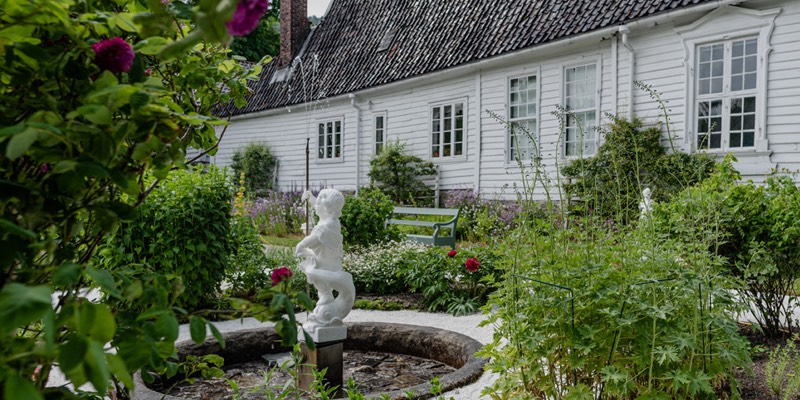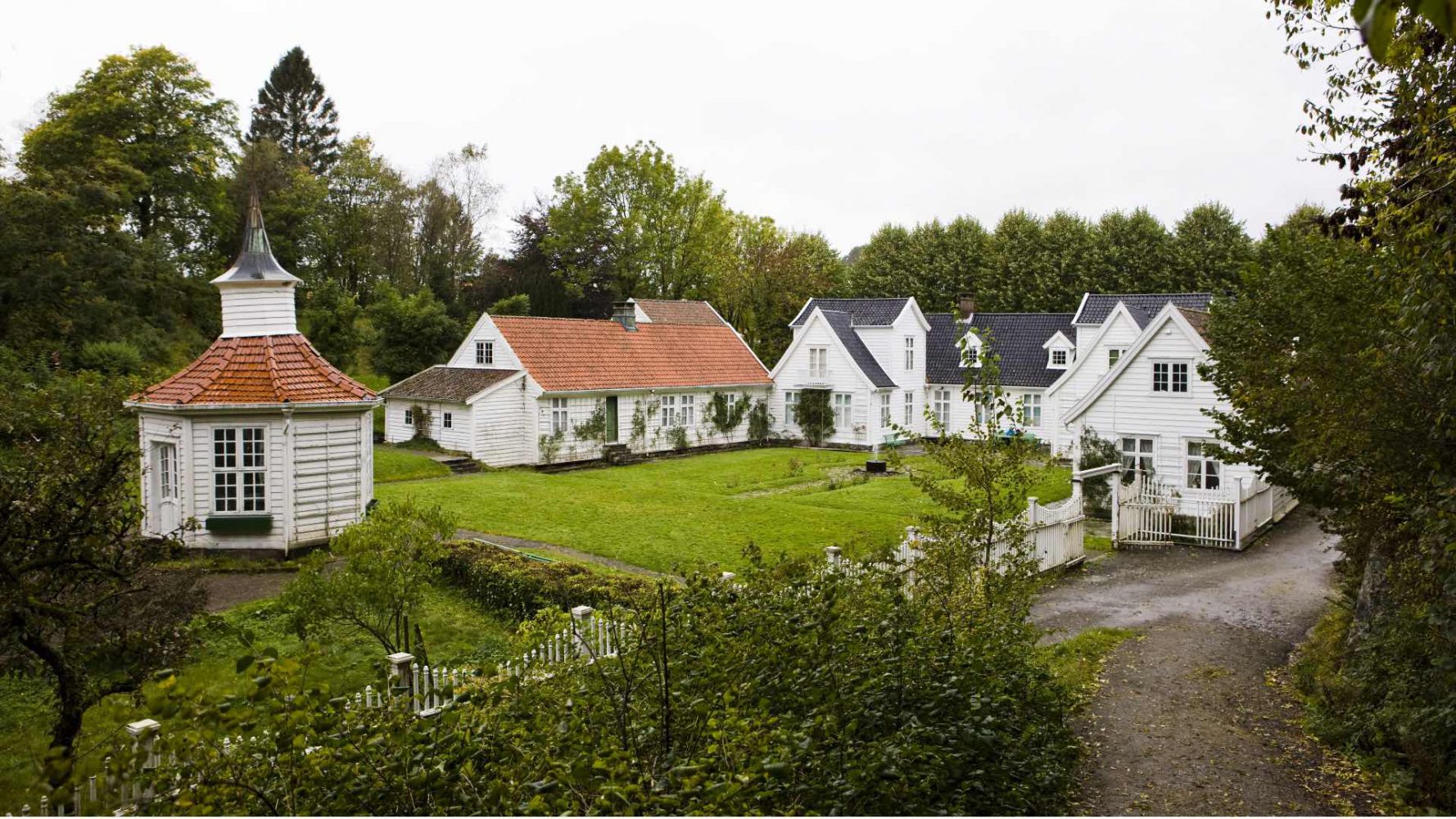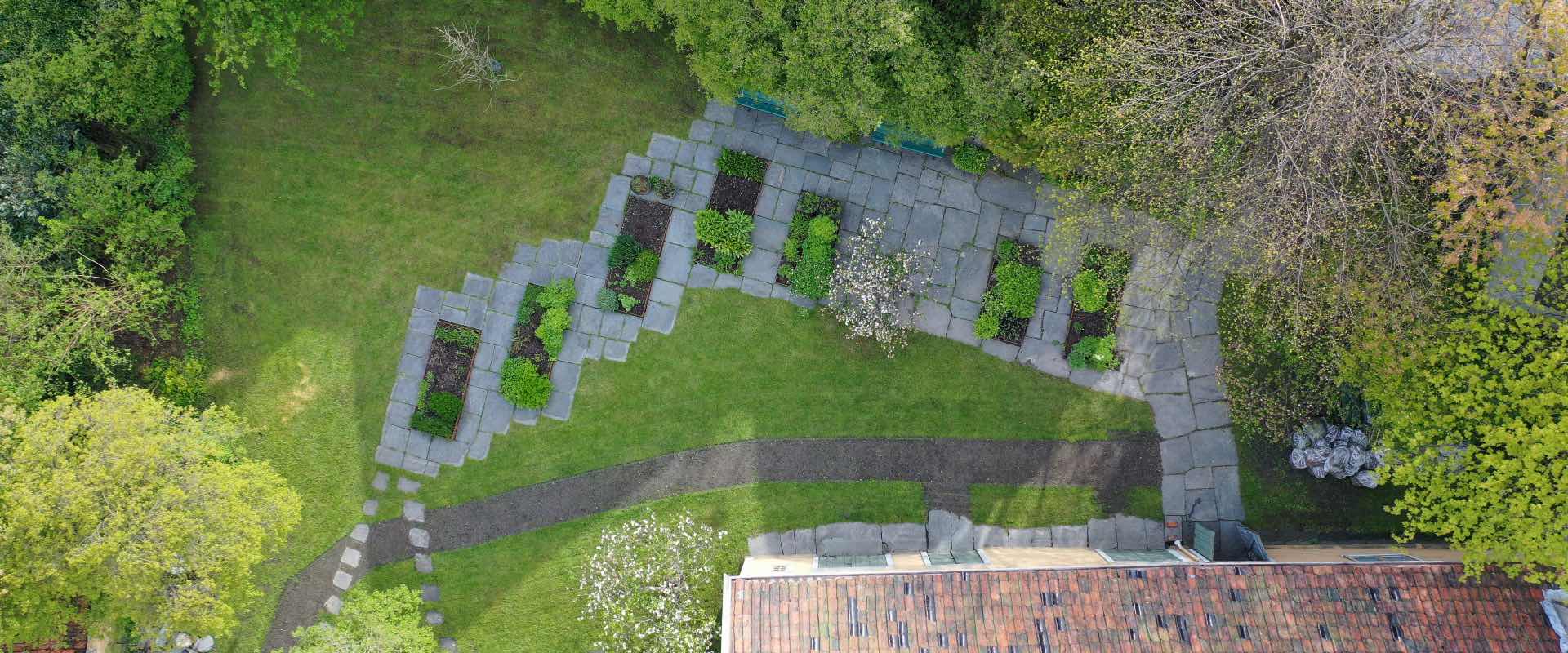Hagene og parkene er sterkt knyttet til helheten i museene de er del av, men de kan godt besøkes uten å gå inn i en eneste bygning. Og de kan med fordel besøkes igjen og igjen og igjen gjennom hagesesongen. Fra vår til høst er de levende museumsutstillinger i stadig endring.
You are welcome to visit the gardens on your own, but we also offer guided tours from time to time in the gardens and parks during season.

The garden is recreated the way it may have been in the 1780´s, showing the typical Bergen pleasure garden both in form and content. The maintenance of the garden is also reflecting the 18th century, featuring organic gardening and manual hand tools.
The formal east garden, the Master´s garden, with straight lawn edges, gravel walks, fountain, 18th century ornamental plants, roses, herbs and vegetables in a beautiful union, like a decorated utility garden. In the east garden you will see the Lady´s garden, which in the 18th century was the back yard. The main elements are the Prussian carp pond and the duck pond. Both gardens have copies of 18th century garden sculptures and benches.
The Gardens are open during opening hours. Entrance fee.
On the south side of the garden, a small Victorian landscape park was established during the early 1800s, the so called “English park”. This park has also been recreated as it may have been in its heyday. It is maintained by Bergen municipality and is open all year round together with the lawn in the front of Damsgård.

In the garden area surrounding the main building, several changes have been made since 1797, when the Fasmer family established their pleasure garden in Alvøen. Today, 18th-century linden tree avenue surrounding the factory in the innermost part of the bay to the main building, the gazebo from 1797, the orchard from the 1880s, the stone flower bed, the roses and the birdbath from the 1930s and contemporary landscape art with Stuart Frost’s decoration in the property’s forest, about the mansion’s long garden history.
As the main building was timely renovated, the garden was changed accordingly. And it was hardly a coincidence that the changes were carried out in accordance with the changing trends of garden art in Bergen. The garden is open for free entrance all year round and is a lovely starting point for walks to the property’s idyllic forest.
The park at Bergenhus Fortress was for the most part formed during the 1830s, when General Carl von Mansbach planted the linden avenue which still exists there. He also created a landscape garden with several paths up to Sverresborg. Much of this was destroyed in the early 20th century, but you can still use Mansbach’s stairs up from Bontelabo and follow one of the old gravel paths up to the plateau.
The garden’s history, however, goes further back to when the area was known as Holmen, and King Magnus Lagabøte in 1275 reserved the area for a new Apostolic Church in the royal courtyard, where they grew herbs, cabbage and apples.
In the 17th and 18th centuries, there were several Renaissance-style gardens at Bergenhus. These were given a freer design in the 19th century. Little is left of these gardens today, although we find a small remnant of the Captain’s Garden south of the Rosenkrantz Tower. Today’s command garden has forerunners dating back to the 1750s. Today, apple trees, ornamental shrubs and roses grow in this garden.
The Norwegian Defence Estates Agency is in charge of the park at Bergenhus. The area is normally open with free entrence all year round. Bymuseet i Bergen offers guided walks at the fortress which gives you the opportunity to learn about the exciting history through a thousand years.

It is uncertain whether the hospital ever had its own herb garden, but we do know that there was agricultural land adjacent to the hospital. Today’s herb garden was established in 1993.
The plant selection in the garden is based on the Dutch Schilling’s treatment methods from the end of the 18th century, which the doctor Daniel Cornelius Danielssen wrote about in the book “About Leprosy” from 1847. The herb garden is maintained by a dedicated group of volunteers throughout the season, and it serves like a wonderful little oasis from a bygone era. The garden is open and free to enter during the museum’s opening hours.

Old Bergen Museum, which opened in 1949, is built on the property of the pleasure garden “Elsesro” which shipbuilder Rasmus Rolfsen built for his wife Elsebe. The property was owned by the Rolfsen family from 1784 to 1903. Here the family also built a shipyard.
Today’s park was considered Bergen’s finest romantic pleasure garden. It was established around 1810 by Rasmus’ son, Tønnes Rolfsen, when returned back home after his journey in Europe. In the diary from the trip, he shows great enthusiasm for the gardens and parks he has seen. He also built his own park with paths, hawthorn hedges and water facilities with falls. The entrance to the park went through the pavilion which is shaped like a Greek temple on the inside. And on the hill the nice little Chinese-inspired gazebo.
The park, which had been a municipal park since 1906, is open and free to enter all year round. It is also a central part of the Old Bergen museum. A walk in the park offers peace, quiet and a lovely view of the city.